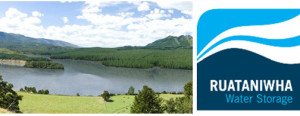 The Environmental Protection Agency (EPA) has granted resource consent to a proposed irrigation dam that will be the largest built in New Zealand for over 20 years.
The Environmental Protection Agency (EPA) has granted resource consent to a proposed irrigation dam that will be the largest built in New Zealand for over 20 years.
The Ruataniwha Water Storage Scheme, led by the Hawkes Bay Regional Council, proposes construction of a major irrigation dam in the Tukituki River catchment.
Extensive modelling and environmental impact assessments carried out by the Council and its contractors arrived at the conclusion that impact on water quality downstream would be minimal, despite agricultural intensification in the region made possible by the scheme.
Critics, including freshwater scientists, disputed this conclusion and alleged that legitimate scientific concerns about the project had been suppressed.
The draft decision, released yesterday, makes consent for the Ruataniwha Water Storage Scheme subject to conditions, including dual-nutrient limits, minimum flow and farm and stock management requirements.
Excerpt from draft decision:
“One of the most contentious features of PC6 as notified was its approach to managing phosphorus and nitrogen. The proposed plan adopted what was described as a ‘single nutrient’ approach focussing on the management of phosphorus. Nitrate-nitrogen controls were only intended to avoid toxicity effects on aquatic ecology.
“Having considered all the information before it, the Board rejected this approach in favour of a ‘dual nutrient’ control which manages both phosphorus and nitrogen. Rather than basing nitrogen limits on toxicity, the Board has taken instream ecological health as the basis of the levels it has set. With the exception of one zone, dissolved inorganic nitrogen levels have been set at 0.8mg/l. The exception is the zone in the headwaters of the catchment where the limit has been set at 0.15mg/l.”
Read the full text of the decision.
The Science Media Centre rounded up expert reaction to the announcement.
Professor Angus McIntosh, Mackenzie Foundation Chair in Freshwater Ecology, School of Biological Sciences, University of Canterbury, comments:
“The Board of Inquiry’s draft decision on the Tukituki Catchment Proposal offers a mixed bag for aquatic ecosystems, but overall there is cause for optimism.
“The blockage to migratory fish caused by the dam will likely see some migratory native fish species lost from the upper catchment. Given the highly threatened nature of New Zealand’s native fish fauna, this is a serious further blow.
“On the other hand, the Board has opted for an enlightened approach to water quality management. Firstly, the management of both nitrogen and phosphorus levels is based on sound scientific reasoning because rivers will almost certainly be limited by both depending on the time and place. Secondly, the use of an index based on stream life as a reliable indicator of ecological health is sensible because ‘life-supporting capacity’ is what we should ultimately be managing for. Finally, the adoption of conservative nitrogen limits reflects the very real likelihood that aquatic life will be degraded at relatively low concentrations.
“Overall, the Board’s adoption of sound scientific reasoning for setting water quality limits is reassuring, and I note the Board expects high-performing farmers to still do well under their proposed regime.”